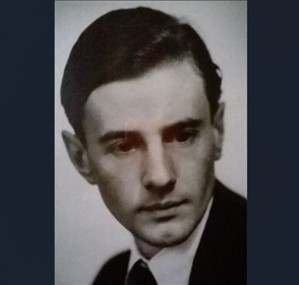
Charles Allberry
Biography
Charles Allberry was born in Sydenham, Forest Hill, south London, on 9th November 1911, one of twin brothers, the eldest children of William Henry Allberry and Hilda Gertrude (née Bonnet). He had also a younger sister and two younger brothers. His given names were Charles Robert Cecil (brought up in the Church of England, he added the name Augustine upon being received into the Catholic Church before his marriage). He was educated at St Dunstan’s College, Catford, south London, from 1922 to 1930. He came up to Christ’s as a classical Major Scholar in 1930, and also held a Tancred Scholarship, as he long considered the possibility of ordination in the Church of England. He was placed in the First Class in the classical Tripos both in Part I in 1931, and in Part II in June 1933. Allberry was quickly recognized as a highly promising scholar. He remained attached to Christ’s, holding a Bachelor Research Studentship from 1934, and a Fellowship from 1935.
A major find of Coptic Manichaean papyrus manuscripts had recently come to light at Medinet Madi in the Egyptian Fayum. In 1930–31, a codex of psalms, divided into two sections, had been acquired together with other fragmentary codices by Sir Alfred Chester Beatty (1875–1968). The papyrus leaves, in a pitiful condition, were conserved in Berlin by the leading papyrus-conservator Hugo Ibscher (1874–1943). A different item from Chester Beatty’s acquisitions, a collection of Manichaean homilies, was published in 1934 by Hans Jakob Polotsky (1905–1991). Allberry’s fascination with Coptic had probably first been sparked by Sir Stephen Gaselee (1882–1943), at the time a Fellow of Magdalene College, and his interests in Manichaeanism (and in Syriac language) were also inspired by Francis Crawford Burkitt (1864–1935), Norris Professor of Divinity and then Norris-Hulse Professor of Divinity, to whose memory Allberry’s 1938 Psalm-book publication was dedicated. The foremost British Coptic scholar of the time was Sir Henry Francis Herbert Thompson, 2nd Baronet (1859–1944), who together with the more retiring Walter Ewing Crum (1865–1944) became close friends and advisors to Allberry. Thompson (who wrote an introductory note to Polotsky’s publication) seems to have taken the lead in proposing that the young Allberry be engaged to publish the second and better-preserved half of the Psalm-book, although it was the Egyptologist Dr Alan Gardiner (Sir Alan Henderson Gardiner (1879–1963)) who secured Chester Beatty’s approval. Ibscher brought the second part of the Psalm-book to London in 1935, and from July 1935 until his death Allberry had actual possession of the leaves. A formidable coalition of British and foreign scholars recommended to Christ’s that Allberry be appointed as the first Budge Fellow, with a specific view to his working upon the Manichaean material. Allberry was appointed in June 1936.
Until early 1938, Allberry worked primarily on his edition of the Psalm-book. However, he also travelled widely. In Spring 1938 he took part in excavations at Medinet Madi, where there were hopes of finding yet more Manichaean texts, and then spent time in Berlin, collaborating with Professor Hans Heinrich Schaeder (1896–1957). He also found time to study Egyptian with Alan Gardiner, and was appointed editor of the Egypt Exploration Society’s Journal of Egyptian Archaeology, as announced by the outgoing editor, Battiscombe Gunn, in JEA 25 (1939), p. 221.
Allberry was an early recruit to the war-time intelligence centre at Bletchley Park, and naturally then had very limited opportunity to pursue his research. It was there that he met his future wife, Patricia Katherine Grace Sandbach. In 1940 he decided to volunteer for service in the Air Force, and enlisted on 4th November 1940. He was editor of the JEA just for volume 26, but stepped down upon joining the RAF, and the next volume was edited by Alan Gardiner (see JEA 27 (1941), p. 161). From June 1941 until July 1942 he underwent training in Canada, but during this time he was also able to travel extensively in North America, including visits to academic colleagues. He became engaged to Patricia in December 1941, returning to England in July 1942. They were married in August. Allberry served in Bomber Command, with the junior ranks of Pilot Officer, then Flying Officer. On 3rd April 1943 he was Navigator on a bomber shot down during a raid against Essen, and was killed with all the crew. He is buried in Eindhoven (Woensel) General Cemetery, Plot JJB, Grave 51. A son, David Charles Anthony Allberry, was born on 31st July 1943, some three months after Allberry’s death.
-
Publications
A Manichaean psalm-book, Part II; ed. by C. R. C. Allberry, M. A., Lady Wallis Budge Fellow, Christ’s College, Cambridge, with a contribution by H. Ibscher (Manichaen manuscripts in the Chester Beatty Collection, vol. 2). Stuttgart: W. Kohlhammer, 1938.
- The volume is dedicated “In memory of F. C. Burkitt” (p. iii).
- Allberry’s Preface, dated “January 1938” states “I hope that it will be possible to publish the earlier part of the manuscript in the course of the next few years”.
- Ibscher’s substantial “Introduction I” (pp. vii-xvii) “Die Handschrift” reviews the acquisition of the fragments, their state of preservation, and his conservation work upon them, explores the nature of the original codex, and discusses the palaeography and binding.
‘Manichaean studies’, The Journal of Theological Studies 39 (1938), pp. 337–349.
‘Das Manichäische Bema-Fest’, Zeitschrift für die Neutestamentliche Wissenschaft und die Kunde der Älteren Kirche 37, (1938), pp. 2-10.
‘Three points in Coptic lexicography’, The Journal of Egyptian Archaeology 25 (ii) (1939), pp. 170–172.
‘Symbole von Tod und Wiedergeburt im Manichäismus’, Eranos Jahrbuch 7 (1939), 113–149.
‘ϯⲟⲩⲟ(ⲉ)ï’, The Journal of Egyptian Archaeology 26 (1941), p. 160. ‘Notes and News’ [unsigned], The Journal of Egyptian Archaeology 26 (1941), pp. 161–162.